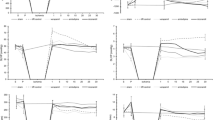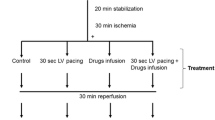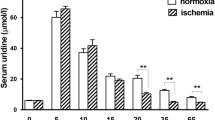Abstract
Calcium antagonists may protect against postischemic reperfusion injury of the heart, but neither the time and mode of action leading to cardioprotection is resolved, nor is the generality of this effect proven. Accordingly, the functional and metabolic influence of four different Ca2+-antagonists (diltiazem, 3×10–8 M; nifedipine, 3×10–9 M; amlodipine, 3×10–9 M; barnidipine, 3×10–11 M) was examined in preparations of guinea pig hearts (n=7/group) performing pressure-volume work after being subjected to low-flow ischemia (30 min) and reperfusion (35 min). The drugs were applied throughout the study at concentrations without negative inotropic or chronotropic effect, as would be mandatory for any therapeutic application, and without overt coronary dilatation.
All calcium antagonists improved postischemic recovery of external heart work: from 42% in controls (post- vs. preischemic value) to 59% for diltiazem, 61% for nifedipine, 65% for amlodipine, and 73% for barnidipine (all P<0.05). Efficiency of myocardial performance (work in relation to oxygen consumption) was low in postischemic controls (8% of total energy equivalents), but significantly improved in treated hearts, especially by barnidipine (15% efficiency). Release of lactate dehydrogenase in the first 5 min of reperfusion, a sign of cell damage, increased from basal (65 mU/min) to 208 mU/min in controls. This increase was fully suppressed by all drugs tested. Myocardial release of lactate and of purine catabolites of adenine nucleotides (markers of anaerobic metabolism) was markedly reduced by Ca2+-antagonists. Interestingly, these metabolic effects were evident not only in the reperfusion phase, but already in the period of low-flow ischemia. Oxidative consumption of pyruvate was enhanced, whereas coronary flow and heart rate showed no postischemic effect of treatment.
These findings on isolated guinea pig hearts suggest that Ca2+-antagonists generally improve postischemic pump function and aerobic metabolism without any requirements for negative inotropic action or coronary dilatation. The protective effects seemed to rely on an attenuation of both ischemic stress and reperfusion damage. This could implicate a benefit from prophylactic use of Ca2+-antagonists in patients at risk for myocardial ischemia.
Similar content being viewed by others
Author information
Authors and Affiliations
Additional information
Electronic Publication
Rights and permissions
About this article
Cite this article
Becker, B., Möbert, J. Low-dose calcium antagonists reduce energy demand and cellular damage of isolated hearts during both ischemia and reperfusion. Naunyn-Schmiedeberg's Arch Pharmacol 360, 287–294 (1999). https://doi.org/10.1007/s002109900053
Received:
Accepted:
Published:
Issue Date:
DOI: https://doi.org/10.1007/s002109900053




